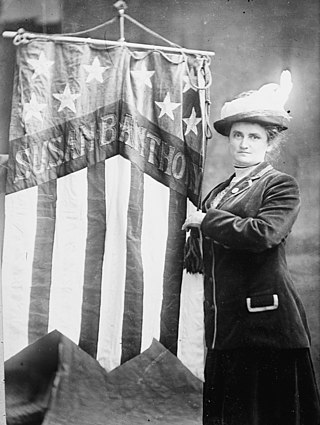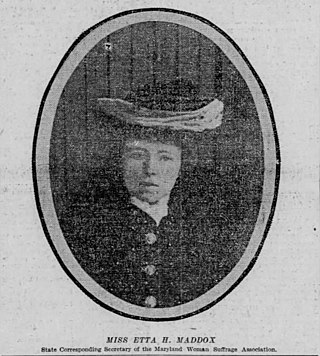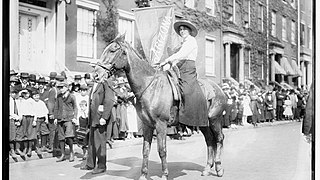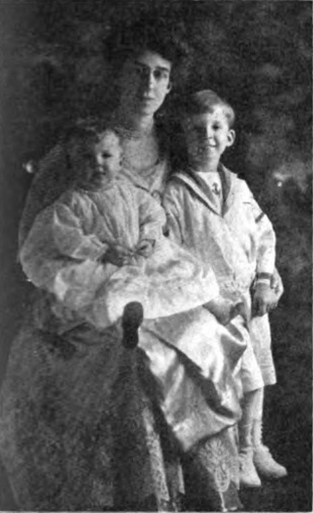
The National American Woman Suffrage Association (NAWSA) was an organization formed on February 18, 1890, to advocate in favor of women's suffrage in the United States. It was created by the merger of two existing organizations, the National Woman Suffrage Association (NWSA) and the American Woman Suffrage Association (AWSA). Its membership, which was about seven thousand at the time it was formed, eventually increased to two million, making it the largest voluntary organization in the nation. It played a pivotal role in the passing of the Nineteenth Amendment to the United States Constitution, which in 1920 guaranteed women's right to vote.

Harriot Eaton Blatch was an American writer and suffragist. She was the daughter of pioneering women's rights activist Elizabeth Cady Stanton.

Martha Lena Morrow Lewis (1868–1950) was an American orator, political organizer, journalist, and newspaper editor. An activist in the prohibition, women's suffrage, and socialist movements, Lewis is best remembered as a top female leader of the Socialist Party of America during that organization's heyday in the first two decades of the 20th century and as the first woman to serve on that organization's governing National Executive Committee.

Nina Evans Allender was an American artist, cartoonist, and women's rights activist. She studied art in the United States and Europe with William Merritt Chase and Robert Henri. Allender worked as an organizer, speaker, and campaigner for women's suffrage and was the "official cartoonist" for the National Woman's Party's publications, creating what became known as the "Allender Girl."

Women's suffrage was established in the United States on a full or partial basis by various towns, counties, states and territories during the latter decades of the 19th century and early part of the 20th century. As women received the right to vote in some places, they began running for public office and gaining positions as school board members, county clerks, state legislators, judges, and, in the case of Jeannette Rankin, as a member of Congress.

The Socialist Woman (1907–1914) was a monthly magazine edited by Josephine Conger-Kaneko. Its aim was to educate women about socialism by discussing women's issues from a socialist standpoint. It was renamed The Progressive Woman in 1909 and The Coming Nation in 1913. Its contributors included Socialist Party activist Kate Richards O'Hare, suffragist Alice Stone Blackwell, orator Eugene V. Debs, poet Ella Wheeler Wilcox, and other notable writers and activists.

Lucy Elmina Anthony was an internationally known leader in the American woman's suffrage movement. She was the niece of American social reformer and women's rights activist, Susan B. Anthony, and longtime companion of women's suffrage leader, Anna Howard Shaw. She served as a secretary to both women, as well as on the committee on local arrangements for the National Woman Suffrage Association (NWSA)

Henrietta Haynie Maddox was a vocalist, lawyer and suffragist. Maddox became the first woman in Maryland licensed to practice law in 1902. She fought for the rights of women to take the bar exam and practice law in the state of Maryland. She was a successful vocalist who studied at the Peabody Conservatory of Music before starting a second career as an attorney. She was the co-founder of the Maryland Woman Suffrage Association in 1894 and campaigned for equal pay for equal work. Maddox wrote the first Maryland suffrage bill introduced to the General Assembly on February 23, 1910.
Amelia "Mimi" Himes Walker was an American suffragist and women's rights activist. Walker was one of the Silent Sentinels who picketed outside of the White House for women's right to vote. She was arrested in 1917 and sentenced to 60 days in the workhouse. After women secured the right to vote, Walker continued to honor the efforts of the suffragists. She also promoted the Equal Rights Amendment (ERA).

The movement for women's suffrage in Arizona began in the late 1800s. After women's suffrage was narrowly voted down at the 1891 Arizona Constitutional Convention, prominent suffragettes such as Josephine Brawley Hughes and Laura M. Johns formed the Arizona Suffrage Association and began touring the state campaigning for women's right to vote. Momentum built throughout the decade, and after a strenuous campaign in 1903, a woman's suffrage bill passed both houses of the legislature but was ultimately vetoed by Governor Alexander Oswald Brodie.

Women's suffrage in Arkansas had early champions among men in the state. Miles Ledford Langley of Arkadelphia, Arkansas proposed a women's suffrage clause during the 1868 Arkansas Constitutional Convention. Educator, James Mitchell wanted to see a world where his daughters had equal rights. The first woman's suffrage group in Arkansas was organized by Lizzie Dorman Fyler in 1881. A second women's suffrage organization was formed by Clara McDiarmid in 1888. McDiarmid was very influential on women's suffrage work in the last few decades of the nineteenth century. When she died in 1899, suffrage work slowed down, but did not all-together end. Both Bernie Babcock and Jean Vernor Jennings continued to work behind the scenes. In the 1910s, women's suffrage work began to increase again. socialist women, like Freda Hogan were very involved in women's suffrage causes. Other social activists, like Minnie Rutherford Fuller became involved in the Political Equality League (PEL) founded in 1911 by Jennings. Another statewide suffrage group, also known as the Arkansas Woman Suffrage Association (AWSA) was organized in 1914. AWSA decided to work towards helping women vote in the important primary elections in the state. The first woman to address the Arkansas General Assembly was suffragist Florence Brown Cotnam who spoke in favor of a women's suffrage amendment on February 5, 1915. While that amendment was not completely successful, Cotnam was able to persuade the Arkansas governor to hold a special legislative session in 1917. That year Arkansas women won the right to vote in primary elections. In May 1918, between 40,000 and 50,000 white women voted in the primaries. African American voters were restricted from voting in primaries in the state. Further efforts to amend the state constitution took place in 1918, but were also unsuccessful. When the Nineteenth Amendment passed the United States Congress, Arkansas held another special legislative session in July 1919. The amendment was ratified on July 28 and Arkansas became the twelfth state to ratify the Nineteenth Amendment.

Hannah Jane Patterson was an American suffragist and social activist. She was a key member of the women's suffrage movement in Pennsylvania and worked for the National American Woman Suffrage Association. During World War I Patterson was a member of the Woman's Committee of the Council of National Defense. For her service, she was awarded with a Distinguished Service Medal. Patterson graduated from Wilson College and studied at both Columbia University and the University of Pennsylvania.

This is a timeline of women's suffrage in Pennsylvania. Activists in the state began working towards women's rights in the early 1850s, when two women's rights conventions discussed women's suffrage. A statewide group, the Pennsylvania Woman Suffrage Association (PWSA), was formed in 1869. Other regional groups were formed throughout the state over the years. Suffragists in Pittsburgh created the "Pittsburgh Plan" in 1911. In 1915, a campaign to influence voters to support women's suffrage on the November 2 referendum took place. Despite these efforts, the referendum failed. On June 24, 1919, Pennsylvania became the seventh state to ratify the Nineteenth Amendment. Pennsylvania women voted for the first time on November 2, 1920.

Women's suffrage in Pennsylvania was an outgrowth of the abolitionist movement in the state. Early women's suffrage advocates in Pennsylvania not only wanted equal suffrage for white women, but for all African Americans. The first women's rights convention in the state was organized by Quakers and held in Chester County in 1852. Philadelphia would host the fifth National Women's Rights Convention in 1854. Later years saw suffragists forming a statewide group, the Pennsylvania Woman Suffrage Association (PWSA), and other smaller groups throughout the state. Early efforts moved slowly, but steadily, with suffragists raising awareness and winning endorsements from labor unions.

Laura Gregg Cannon was an American lecturer and organizer in the women's suffrage movement. Over the course of almost three decades, she led or supported suffrage activities in fifteen different states. She was a Life Member of the National American Woman Suffrage Association (NAWSA). Cannon edited a suffrage publication and wrote on labor issues. She was a national speaker for the Socialist Party.

Annie Louise Hall was an American suffragist and saleswoman. Hall worked as a teacher for many years, but after her experiences at a settlement house in New York City, she turned to suffrage work. Hall had experience working for women's suffrage in Connecticut, Massachusetts, New Hampshire, New York, Ohio, Pennsylvania, and Rhode Island. After her women's suffrage work, she went on to work as a saleswoman and eventually retired with her life partner to Ojai, California.

Jennie Eliza Kennedy was an American clubwoman and suffragist. Kennedy was one of the activists that helped create the "Pittsburgh Plan" as a women's suffrage strategy.

Lucy Kennedy Miller (1880–1962), also known as Mrs. John O. Miller, was a prominent 20th-century American suffragist who became the president of the Equal Franchise Federation of Pittsburgh, Pennsylvania and the first president of the Pennsylvania League of Women Voters (PLWV). In 1919, the League of Women Citizens of Pennsylvania called her "the woman to whom, more than to any other" was "owe[d] the triumph of" women's suffrage in the Commonwealth of Pennsylvania.

















